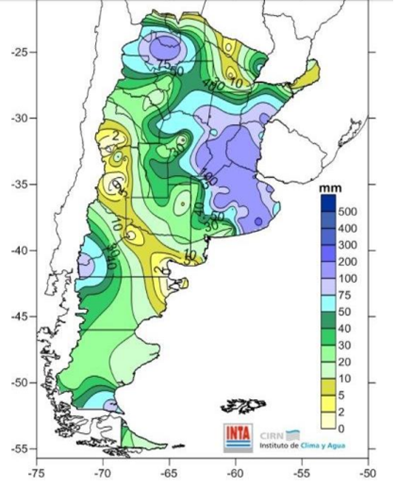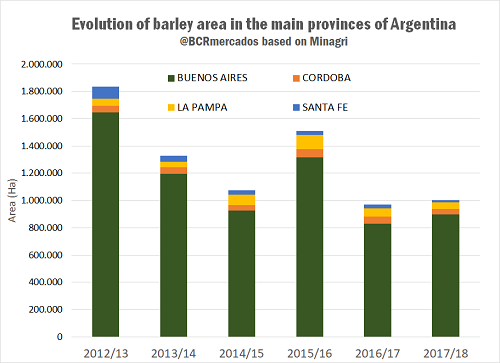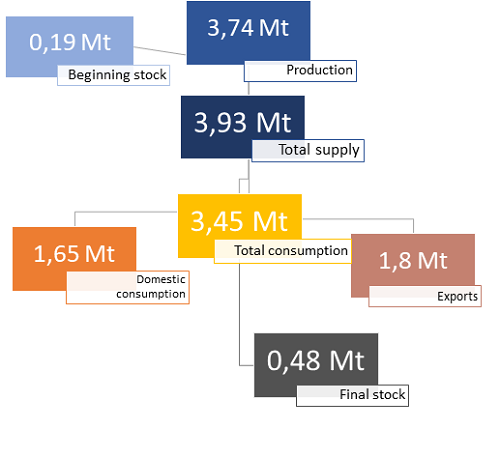On previous week FOB prices of Argentine soybean byproducts have maintained an upward path, improving the gross margins of the processing industry and increasing the price paid for spot soybeans in argentine pesos. This was seen in the Rosario Board of Trade's negotiations on previous week. The aforementioned improvement in the FOB prices of the by-products was given by better buyer premiums offered on the Chicago contracts for the FOB meal, increasing 8.8 USD / Tn (ascending from +13 USD / St on the future May 2018 of Chicago on last Thursday at +21 USD / St on Tuesday), and for better premiums for FOB oil, increasing 4.4 USD / Tn (rising from +2.60 USD / lb over the future May 2018 to +2.80 USD / lb). In this way, calculated to last week's Wednesday with their respective premiums and contracts, prices totaled 743.83 USD / Tn and 448.08 USD / Tn for oil and meal respectively. Integrating the theoretical FAS for the Argentine industry to April 25 at 323.5 USD / Tn, an increase compared to previous Thursday of 12.5 USD / Tn. On last week's Thursday, furthermore, the Rosario Board of Trade's soybeans reference price was calculated at 313.9 USD / Tn continuing with the bullish path of the week. In the forwards market, bids for deliveries in July and November reached US $ 320 and US $ 332 per ton respectively. The July position climbed 10 USD / Tn on Thursday 26.
The US trade dispute paralyzes businesses, turning operations to Argentine markets The trade dispute between the United States and China, the two most important economies in the world and two of the most important players in the international soybean trade, continues to influence the oilseed market. The last two weeks have marked a clearly bearish trend in Chicago and this is mainly due to the stoppage of purchases of US soy by China. The last export sale to China reported by the United States Department of Agriculture (USDA) was on April 10. The announcement made at the two weeks ago by the Chinese government of the imposition of anti-dumping duties on sorghum from the USA generated fears among market participants. After this measure, according to Chinese traders consulted by the Reuters news agency, none is willing to take the risk of importing soy from North America in the face of possible new restrictions to curb imports of the agricultural product with greater participation in trade between these two countries.
As a result, the differential between Brazilian and US prices has risen according to Reuters in recent weeks. Last Tuesday, Chinese customs data showed that imports of soybeans from the United States fell by 27% in March compared to the same month of the previous year, while purchases to Brazil increased by one third. Seasonal factors should not be ignored, when analyzing this drop in export sales of US soybeans to China. Soybeans recent harvest in South America tend to dominate world trade in the first half of the year, while that from the United States comes from September. However, in recent days there has been a recovery in the values of soy in the Chicago market, which seems to be associated with new export businesses reported by the USDA, after two weeks without news, and announcements of upcoming negotiations that could reduce commercial tensions. Corn down in line with the external price The values offered in Rosario for physical corn with immediate delivery decreased in the week as a result of lower export prices. The Official FOB price for the shipment of May from the Ministry of Agro-industry went from 192 USD / ton on Thursday, April 19 to 189 USD / ton on last week's Wednesday. FOB prices for future shipments were also to the downside. The month of July coincides with the Brazilian harvest which could give a bullish movement to cereal prices. According to several analysts, the Safrihna (Brazil's second maize crop) this year could suffer due to the water deficit. With extremely dry forecasts on the horizon, analysts fear that the dry season arrives earlier than usual. Up to 20 percent of Brazil's maize crop could be at risk in the short term, and an additional third could be added if the rains ended prematurely. The Safrinha harvest is expected to represent 71 percent of the country's total maize production by 2018. This crop harvested in winter is very important because it will determine how much corn is available for Brazil's export program and therefore in the shipments from our country.


